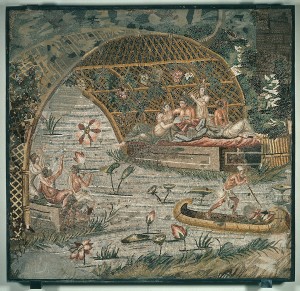Cultural Cocktail Hour
Beyond the Nile- *A MUST SEE* EXHIBIT in LA
“Beyond the Nile” at the Getty Center- A MUST-SEE Exhibit
by
Leticia Marie Sanchez
Fasten your artistic seat belts.
The Getty Center’s “Beyond the Nile: Egypt and the Classical World” is truly a blockbuster show, spanning more than 2000 years and covering geography ranging from Minoan Crete, Hadrian’s Rome, and Ancient Egypt.
What is inspiring about the exhibit is that the civilizations of Egypt, Rome, and Greece are not viewed as separate entities. In fact, the exhibit’s main theme explores the influence that these cultures had one another. Egypt’s impact went beyond the Nile, and its presence can be seen in the Classical world’s frescoes, coins, sculpture, and pottery in an enriching exploration of artistic cross-pollination during antiquity.
And there is nothing that Cultural Cocktail Hour enjoys more than a magnificent fusion. It underscores the fact that as human beings, we have more that unites us than separates us. Art is a lens that can depict the thriving connection between distinct cultures.
Here are some FUN FACTS about the exhibit:
1. A TRULY GLOBAL ENDEAVOR Of the more than 300 works on display, surprisingly only 3 (!) come from the Getty’s collection. Getty Museum Director Timothy Potts revealed that the rest hail from a vast array of museums around the globe, including the British Museum, the Louvre, The National Archaeological Museum of Naples, and the Berlin State Museum.
2. “SCULPT LIKE AN EGYPTIAN” : Senior Curator Jeffrey Spier revealed that Ancient Greek sculpture was heavily influence by Egyptians. The Greeks did not carve stone sculpture prior to the seventh century B.C. But after seeing Egyptian images, the Greeks began creating Kouroi (figures of young men) and Korai (Figures of young women). When observing these Greek sculptures, look for clenched hands held tightly at the sides, the visual links to the Egyptian sources of inspiration.
3. BUDDY, CAN YOU SPARE A HEAD?“ Senior Curator Spier also revealed that many of the heads that we see would have been full figured. And in fact, many tombs contained a “RESERVE HEAD” like a “spare tire!”
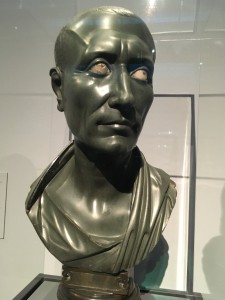
(This image is NOT a reserve head. This is JULIUS CAESAR.)
Unknown. The Green Caesar.
1st Century B.C-1st Century A.D. Roman.
Green Slate.
Object. H: 44 X W:26 X D:25cm (17 5/16 X 10 1/4 X 9 13/16 in.)
Photo credit: bpk Bildagentur/Antikensammlung, Staatliche. Museen zu Berlin- PreuBischer Kulturbesitz/Art Resource, NY EX: 2018.4.66
“BEYOND THE NILE” warrants several visits to take in the manifold objects spanning countries and centuries.
DO NOT MISS these highlights on your first visit:
#1. In the Museum Entrance Hall, visitors are greeted by the BENEVENTO OBELISK,
found in Benevento, Italy. This Roman-Egyptian obelisk honors the Emperor Domitian and the Goddess Isis. The obelisk sets the tone for what one will view inside. Isis was a significant goddess in Ancient Egypt, but her popularity transcended the land of the Nile. The Greeks viewed her as manifestation of Aphrodite, and she also gained a cult following in Rome. So, this first piece heralds the notion of cultural fluidity that will be a cornerstone of the exhibit.
OBELISK HONORING EMPEROR DOMITIAN AND THE GODDESS ISIS; Romano-Egyptian, AD 88–89, found in Benevento, Italy; granite. Museo del Sannio, Benevento
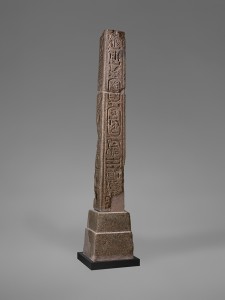
#2. STAIRCASE LEADING TO THE EXHIBIT-
“Walk like an Egyptian!”
(Cue the Bangles:
“All the old paintings on the tombs/
They do the sun dance don’t you know?”)
The intricately designed staircase leading to the exhibit is just one of many creative details at the exhibit.
This transportive staircase allows one to travel back in time with majestic flair, robes fluttering in the LA breeze, like Egyptian deities.
One feels like a pharaoh and can unleash one’s inner goddess.
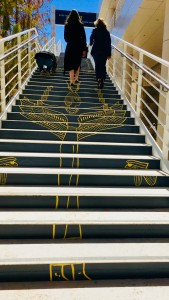
#3: Unknown MARBLE HEAD OF ALEXANDER THE GREAT
2nd-1st century B.C, Egyptian, Ptolemaic, Marble. Object: H. 38.1 X W: 22.0 X D: 24.1 cm (15 X 9 X 9 ½ in) © The Trustee of the British Museum. EX 2018.4.28
This is a key figure to recognize! You will see his image throughout the exhibit. In fact, when Ptolemy 1 became the king of Egypt in 305 MC, he elevated Alexander the Great to god-like status with a cult that deified the conquering hero. Some visual clues to Alexander’s portraiture: the leonine hair with curls raised above the forehead and youthful mien. (After all, Alexander created one of the largest empires ever before he reached the ripe old age of 30. Not too shabby).

#4. CUP WITH EGYPTIAN SCENES Roman 25 BC- AD 79; found in Stabiae, Italy. Obsidian with pink and white coral, carnelian, jasper, lapis lazuli, and malachite framed in gold.
This cup captivated the attention of many museum goers at the Getty during my visit; I observed them transfixed by this glowing cup, as they walked around to capture the various angles as light streamed through the obsidian glass. The luster of the glass stems from its origin as black volcanic glass. Its mesmerizing property extends to the colorful semiprecious stones which depict Egyptian scenes, including the sacred Apis bull and Horus falcons. Other symbols include a solar disk with two royal cobras known as uraei.
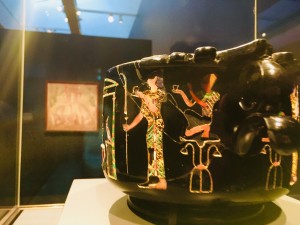
#5 MOSAIC WITH A VIEW OF THE NILE, Roman, 100 BC–AD 100, found in Palestrina, Italy; stone. Staatliche Museen zu Berlin, Antikensammlung. Photo: bpk Bildagentur / Antikensammlung, Staatliche Museen/Photo: Johannes Laurentius /Art Resource, NY
This Mosaic is also not to be missed.
Restored by the Getty, it was originally part of an immense floor mosaic nearly twenty feet long. Thus, the level of detail on this mosaic is breathtaking. Again, the confluence of cultures is evident in this piece which was discovered in present-day Palestrina, east of Rome, yet depicts an Egyptian scene: an Egyptian steers a boat on the Nile, where a festive group is serenaded by musicians. Incidentally, the depiction of the Nile on the original piece extended from Ethiopia in the South to the Egyptian delta on the Mediterranean coast.
